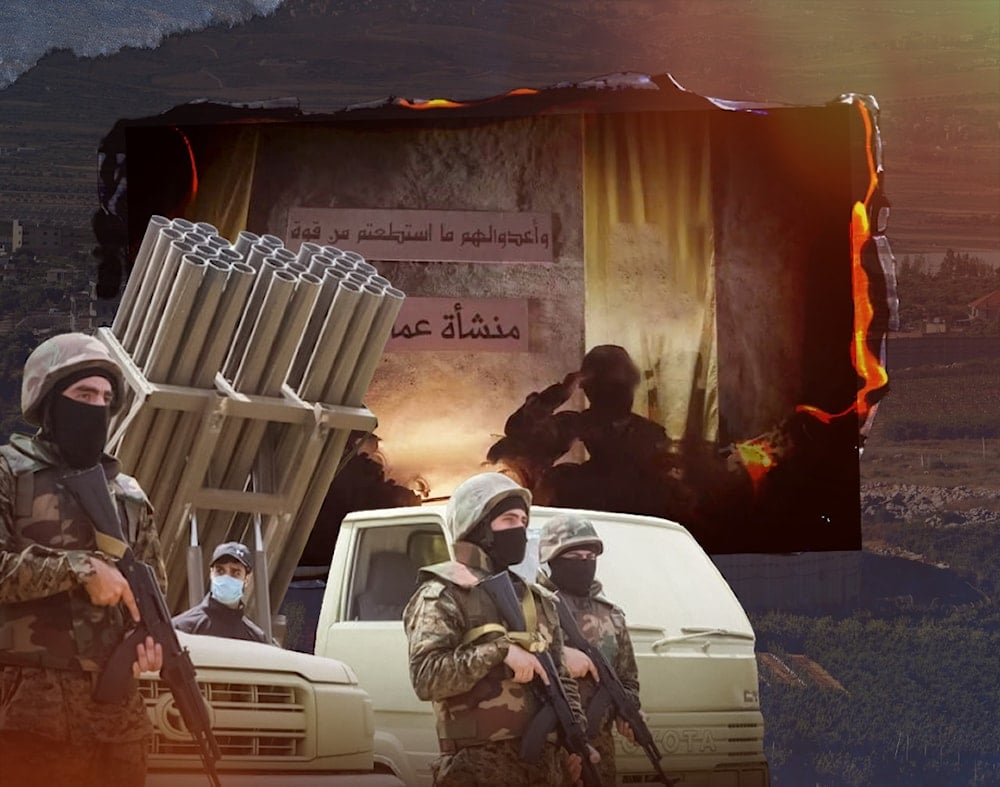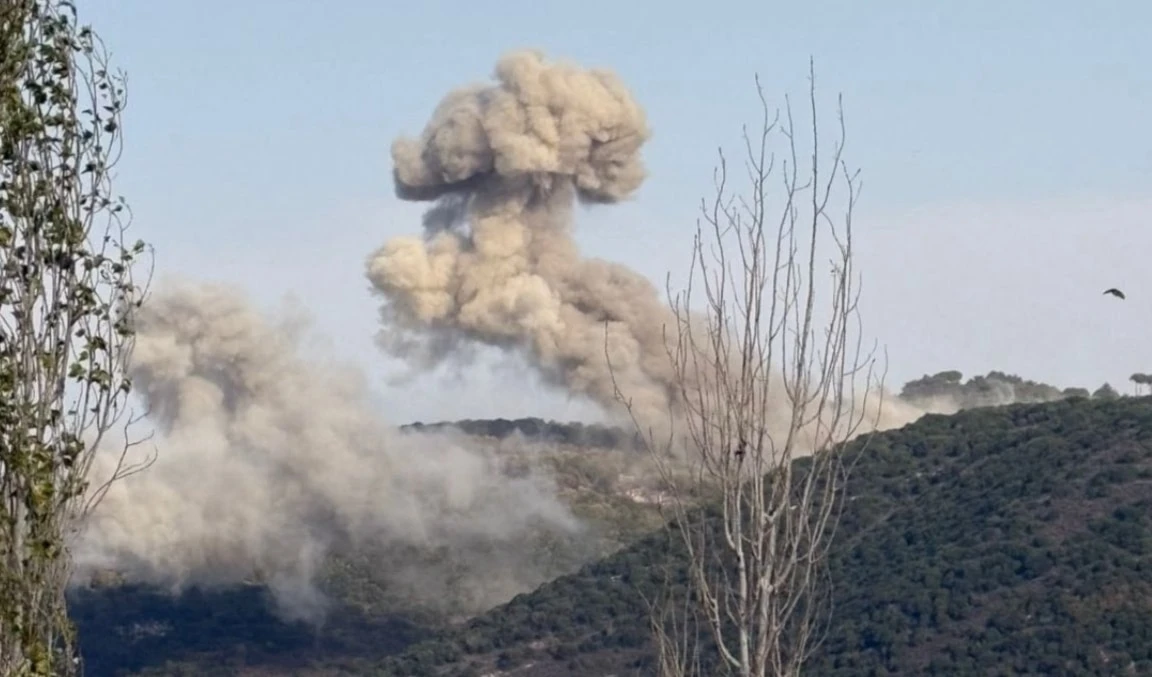Hezbollah's increasing threat to Israeli security
From its drone fleet reigning the skies to deeply fortified missile facilities concealed underground, Hezbollah continues to threaten "Israel's" security.
-

From skies to tunnels: Hezbollah's growing threat to Israeli security. (Designed by Ali Al-Hadi Shmeiss, Al Mayadeen English)
While the Islamic Resistance in Lebanon - Hezbollah has explicitly stated that it does not seek war, this should not be mistaken for a lack of readiness or capability. Hezbollah has effectively showcased its intelligence and operational prowess time and time again.
Over the years, Hezbollah’s intelligence and operational capabilities have undergone remarkable advancements, enabling the group to pose a serious challenge to Israeli security and intelligence on multiple fronts. From its drone fleet reigning the skies, unintercepted, to deeply fortified underground missile facilities, Hezbollah has strategically exceeded "Israel's" expectations.
Hezbollah’s aerial intelligence
During the 1990s, Hezbollah's intelligence capabilities blossomed against the backdrop of the Israeli occupation of Lebanon. As the confrontations intensified, Hezbollah’s ability to gather, analyze, and act on critical information further developed. This period marked a turning point, showcasing Hezbollah's evolution into a highly effective and coordinated force capable of challenging one of the region’s most powerful militaries.
Erez Gerstein's assassination
Brigadier General Erez Gerstein, who headed the IOF’s Liaison Unit in Lebanon, became a primary target of the Israeli incursions into South Lebanon because of his active participation in coordinating strikes with the Lahd forces – collaborators who were turned into an anti-Resistance mercenary force to replace “Israel’s” presence in South Lebanon. His importance was also associated with the fact that he coordinated Israeli activities in his area of responsibility. The skill with which such a senior military figure had been targeted necessitates a good deal of sophistication concerning the means available to Hezbollah.
Undoubtedly, the intelligence networks that were placed within the Israeli military, with respect to his operational order, were sophisticated enough to monitor and understand every detail of his operational order.
The operation for the Gerstein assassination was conducted on the 28th of February 1999, while applying a great deal of care and exactness. Fighters from Hezbollah bombed a stretch of the highway, which was regularly utilized by Gerstein’s convoy. Apart from bettering the group’s Israeli-killing bingo cards, eliminating this man made known to them within the group:
Hezbollah's intelligence in al-Naseriya
Hezbollah showcased its intelligence was on full display during the standoff at al-Ansariyyah, a village located in South Lebanon, back in 2008. The vibrant region is of strategic importance because of its link to the Israeli Southern Frontier. The magnitude of the Hezbollah counterintelligence efforts is clear because the local informants that they had recruited were monitored utilizing sophisticated surveillance systems.
By withstanding Israeli intelligence efforts in al-Ansariyyah, Hezbollah showcased its all-encompassing operational prowess, bringing forth one critical paradigm: al-Ansariyyah is home to one of the more sophisticated intelligence networks operated by Israelis around the world. The combination of Israel's sophisticated wonders and capabilities proved to be futile vs the grassroots level_local intelligence countermeasures awaiting them. Resistance succeeded in the face of defeat owing to timely information saturation. Providing multi-layer cover and countermeasures, they countered the Israeli attempt to breach their core infrastructure while coming out on top.
What made this achievement particularly notable was the context concerning “Israel”. In the region, its intelligence sections and other associated bodies for example, Mossad Aman operate on open, broad spectrum, advancing STEM branches predicated including SIGINTs, voyeurism, and espionage execution_domainillugit
Mirsad-1, Mirsad-2
The Mirsad-1 and Mirsad-2 drones are considered historical examples of Hezbollah's early drone capabilities. Since their initial use in the mid-2000s, Hezbollah has significantly advanced its drone technology.
The Mirsad-1 was unveiled on November 7, 2004, as it made its first known flight into occupied Palestine's airspace, going from northern occupied Palestine all the way to Nahariya. The flight lasted about 20 minutes, and the drone returned safely to Lebanon. This was a significant moment, as it marked Hezbollah’s first successful use of a UAV over the occupied territories.
Between 2005 and 2006, the Mirsad-2 was reported to have been used in subsequent reconnaissance missions. While specific dates of flights remain unclear, these operations took place mainly during the period leading up to and during the 2006 July War.
Ayoub drone
The Ayoub drone represents a significant advancement in Hezbollah’s unmanned aerial vehicle (UAV) capabilities. Making its first appearance in 2019, the Ayoub drone flew over occupied Palestine's airspace, gathering intelligence and testing Israeli air capabilities.
The drone was equipped with high-resolution cameras and other sensors that enabled it to gather detailed imagery and real-time intelligence on Israeli military installations, infrastructure, and other strategic targets. The successful infiltration of the Ayoub drone highlighted Hezbollah’s ability to cut through Israeli security and project power.
The Hoopoe drone series
The Hoopoe drone series, released amid the ongoing war on Gaza, served as a powerful illustration of Hezbollah’s intelligence prowess. The name, taken from the Quranic symbol of a skilled bird messenger, reflects Hezbollah’s strategic intent, which is to demonstrate that it has eyes on critical Israeli infrastructure and that it can infiltrate Israeli security undetected. The series also demonstrated Hezbollah's intelligence capabilities, as they revealed specific details of the footage the drone came back with.
In these videos, Hezbollah’s drones returned with high-resolution imagery of key targets like Haifa Port, Rafael’s military-industrial complex, and densely populated urban areas such as the Krayot. The detailed footage of strategic sites is a stark reminder to "Israel" of the extent to which Hezbollah’s intelligence capabilities have grown. The message is clear, Hezbollah can monitor, surveil, and potentially strike high-value targets with precision at any time.
In the first video release, titled "This is what the Hoopoe came back with," the nine-and-a-half-minute video captured footage and exposed sensitive Israeli sites. The published footage included intelligence about Israeli sites inside occupied Palestine and clearly showed that the drone arrived at the port of Haifa intact.
Hezbollah's drones brought back footage and information about sensitive sites they captured over Haifa, starting with the port itself, to oil refineries and military factories, not to mention the locations of military battleships and important economic hubs in the port.
In the second video release, the 10-minute video showcased footage of six strategic electronic reconnaissance sites in the occupied Syrian Golan; the western and eastern Shlagim sites, the Astra site, the Yisraeli site, the Avital site, and the Tel Fares site. According to the information provided in the video, these Israeli sites are tasked with espionage, guidance, long-range monitoring, and electronic attacks involving jamming and subterfuge.
In the third video release, the special episode showed the Ramat David Airbase, the only Israeli military airbase in northern occupied Palestine, which is 46 km away from the Lebanese border. The video captured by the Hoopoe drone, which successfully evaded Israeli surveillance and interception systems for the third time, showed all the facilities associated with the Ramat David airbase.
Underground fortifications: Imad-4 missile facility
The recent unveiling of the Imad-4 missile facility further emphasized Hezbollah’s advancement in both intelligence and strategic deterrence. This hidden facility houses long-range ballistic missiles, designed to remain undetected by Israeli intelligence. By revealing this site, Hezbollah aims to counter Israeli narratives that aim to downplay its capabilities, while asserting that its strategic weapons are well-protected and ready for action.
Analysts suggest that Hezbollah's video may have conveyed a subliminal message, implying that the missile facility could be located in the occupied al-Jalil, within the occupied territories, or potentially lead to a site inside the occupied territories.
The Imad-4 video, titled “Our Mountains, Our Strongholds” further underscores Hezbollah’s message and serves as a rebuttal to years of Israeli propaganda focusing on the so-called “storehouses” narratives, which suggested that Hezbollah’s missiles were poorly hidden among civilian infrastructure. The reality, as demonstrated by the group’s underground silos and fortified bunkers, is far more sophisticated. The Resistance’s methods of concealing and deploying its missile arsenal present a formidable challenge to any Israeli plans for preemptive strikes.
The Islamic Resistance in #Lebanon, #Hezbollah, published a new video of a sophisticated underground facility and tunnel network that includes missile launchpads.
— Al Mayadeen English (@MayadeenEnglish) August 16, 2024
The video serves as a clear message to the Israeli occupation amid the growing tension on the Lebanese-#Palestinian… pic.twitter.com/KTSUfhBmfG
Israeli media referred to the missiles revealed in the video as "doomsday weaponry" and noted the extensive and well-equipped nature of these facilities, which include features, such as illuminated tunnels, missile launchpads, and extensive storage areas.
As the Resistance released footage of the Hoopoe drones, Hoopoe 1, 2, and 3—each in a clear, sequential order, the appearance of the Imad-4 facility in a jarring, out-of-sequence reveal introduces an intriguing twist.
Might this deliberate chronological anomaly signify something more encoded, perhaps a discrete countdown to a pivotal moment?
The regional front
The timing of these revelations is no coincidence. With the genocide ongoing in Gaza and increasing pressure on the northern front, Hezbollah’s display of its intelligence and operational capabilities stands as a stark warning. Politically, it provides leverage to Palestinian factions, particularly Hamas, during ceasefire talks. Militarily, it sends a message to Israeli decision-makers that any escalation will come at a hefty price. By unveiling its underground and aerial strengths, Hezbollah is forcing "Israel" to reconsider the potential consequences of further escalation or even a full-scale war.
While Hezbollah's intelligence capabilities in the air and underground have become increasingly developed, the group's maritime strength is not a new concern for "Israel". In 2006, during the July War, Hezbollah showcased its naval prowess when it struck the Israeli Sa’ar 5-class INS Hanit warship off the coast of Lebanon. This surprise attack was a pivotal moment, demonstrating Hezbollah's ability to effectively undermine Israeli naval supremacy using anti-ship missiles.
So, the question remains: with Hezbollah unveiling its capabilities and prowess in the air and underground, does the future hold any similar achievements to be unveiled from the depths of the sea?

 9 Min Read
9 Min Read










